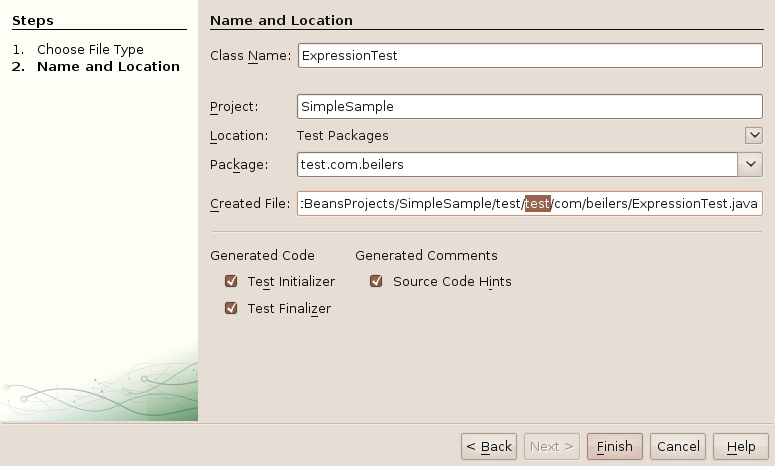 I seem to work on a variety of Java applications and find that unit testing is one of the most varied (implementation-wise) pieces of the development process. These applications, created by different development staffs, many which have evolved over the pass few years are all very unique… kind of makes me wonder why? That is a topic for another post!
I seem to work on a variety of Java applications and find that unit testing is one of the most varied (implementation-wise) pieces of the development process. These applications, created by different development staffs, many which have evolved over the pass few years are all very unique… kind of makes me wonder why? That is a topic for another post!
One debate I always seem to encounter is around where to actually save the unit tests? Should we do in-package testing or rely on the public API. My preferences are pretty simple:
- Unit test should not be stored with the code, but rather created under a secondary source root. On my early projects, I created a sub-package under each package, called test, to manage the relevant files (tests and data). I later realized that I could simplify the Ant build process and enable in-package testing by creating a separate source tree. I have seen projects commingle the actual source code, unit tests, and even the test data files, all within the single source tree. This defaults the testing strategy to in-package testing, and discourages (or even prevents) API testing. I find this approach rather messy and unclear. This approach also complicates the Ant build process; at some point during the process, the unit tests, supporting classes and files should be separated from the actual deployable content.
- I like to name my secondary source root tdd. I know it is not widely practiced, but my hope is that if the developers see that TDD directory every time the open up their IDE, the concept might actually wear off! Maybe someday, one developer (hopefully more) will actually be challenged to write their unit tests first. With Eclipse and jUnit 4.x annotations, I seem to always start with my unit test, and sometimes even refactor code from the unit test into the actual class; kind of a high-bread TDD process, but the thought is always there!
- I also prefer the public API testing strategy verses in-package testing. This line of thinking always takes me back to the Testability Explorer. The concepts behind this metric enforce the idea public API testing and is worth a quick read. Add the Spring Framework to the mix, enabling dependency injection and I see little need for in-package testing. This is typically accomplished by creating a “test” package as the root of the secondary source tree, with sub-packages reflecting the package hierarchy of your classes to be tested. I truly believe that defaulting to in-package testing allows the developers to be very sloppy and even unaware that they are testing a specific internal implementation, rather than externalized behavior presented by the API… This is VERY bad practice in my opinion.
- If there is a need for in-package testing, then the sub-package structure of the classes to be tested can be recreated under the secondary source tree, maintaining a clean separation between the source and test cases. These test should be considered an exception to the norm, rather than common practice. I would hope for a 90-10 or 80-20 ratio, with a majority of the test falling under the test package root (in-package is the minority).
 I am kind of tied to Eclipse as my IDE, but do play with NetBeans every so often. I think I could switch to NetBeans, my only real requirement is that the IDE must have Emacs key bindings; some habits are just too hard to break! NetBeans looks like an pretty good tool and seems to be very responsive on my Ubuntu box; I especially like the way it manages plug-ins. One interesting thing that NetBeans does (maybe a little better than Eclipse), is manage unit testing. NetBeans will automatically create the secondary source tree, but seems to default to in-package testing. It is very easy to add the additional test package into the package structure to enable API testing. I also like the way that NetBeans separates the Test Libraries from the regular Libraries. I’m not sure how well this would work when you use a tool like Ivy, but does make it more obvious, as to which libraries are used for execution verses unit testing… If you do happen to generate a unit test from an existing class, NetBeans will generate more code than Eclipse. I’m not sure how useful this code is, but it does try to create the object under test, invoke the get() methods and perform assertions on the returned values. Might be more noise that it is worth, and anyway, you should be writing the unit test first!
I am kind of tied to Eclipse as my IDE, but do play with NetBeans every so often. I think I could switch to NetBeans, my only real requirement is that the IDE must have Emacs key bindings; some habits are just too hard to break! NetBeans looks like an pretty good tool and seems to be very responsive on my Ubuntu box; I especially like the way it manages plug-ins. One interesting thing that NetBeans does (maybe a little better than Eclipse), is manage unit testing. NetBeans will automatically create the secondary source tree, but seems to default to in-package testing. It is very easy to add the additional test package into the package structure to enable API testing. I also like the way that NetBeans separates the Test Libraries from the regular Libraries. I’m not sure how well this would work when you use a tool like Ivy, but does make it more obvious, as to which libraries are used for execution verses unit testing… If you do happen to generate a unit test from an existing class, NetBeans will generate more code than Eclipse. I’m not sure how useful this code is, but it does try to create the object under test, invoke the get() methods and perform assertions on the returned values. Might be more noise that it is worth, and anyway, you should be writing the unit test first!
The bottom line is that Unit testing should be easy and valuable. If it becomes too hard or complicated, it might be time to re-address how the unit test strategy is being implemented.










